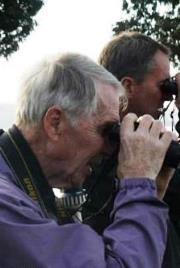Birds of the Happy Valley Forest (Part Four)
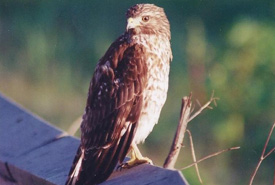
This hawk lives in closed canopies such as those found in Happy Valley and thrives on small mammals and birds. (Photo by Dr. Henry Barnett)
During our five-year participation in Ontario in the Breeding Bird Census, daughter Ann Love and I found 109 breeding species in the Happy Valley Forest area or species seen regularly overhead in breeding season.
The Happy Valley Forest has no shortage of resident raptors. One of its spectacular residents is the red-shouldered hawk.
No hawk is a more frequent crier than the red-shouldered hawk. I first heard them the day of our first visit to the Happy Valley Forest in 1959. They cry out regularly from March to September.
They use their crude-looking stick nest sometimes two or three times in the same part of the forest and occasionally use the same nest in successive years. They are now upgraded from the endangered list because of the existence nowadays of a number of protected forests.
The broad-winged hawk breeds and summers in the Happy Valley Forest, as does the sharp-shinned hawk and the merlin. Their young just out of the nest are noisy and greedy enough to attract the observer, and betray their nesting site.
Cooper’s hawk nests and raises their noisy young close to where we used to live in the forest. On one hot summer day the two young were sitting noisily in our bird bath, heads overlapping at one end, tails at the other.
A goshawk repeatedly uses the same tree at the forest’s easternmost edge. When nesting, the female swoops down to peck at the heads of the swimmers in the adjacent pool. They took to wearing rubber swimming caps to protect their scalps.
Another noisy bird includes the kestrel — the smaller of the falcons. They were common in the Happy Valley forest area in the beginning of our sojourn here. Now they are much less frequent for unknown reasons.
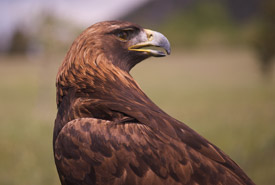
Golden eagle (Photo by NCC)
Eagles
The eagles of the whole world (bald and golden in North America) fell victim to tons of DDT sprayed during the mid part of the last century. When science and understanding of the impact of the spray resulted in its ban in Canada and the US, the eagles recovered as did the failing osprey.
The largest buteo, the rough-legged hawk, visits us only in winter. They approach the eagle in size and strength but nest on the tundra in the high Arctic. Many of them spend winters in southern Ontario and Northern New York and other adjacent States.
One Canadian Thanksgiving when our family was assembled for the festive meal we were interrupted by the arrival of a mature golden eagle landing in the dead apple tree in front of the house (150 feet away). He stayed long enough to be observed by all by telescope and then we ate a cold dinner.
Owls
Owls in the forest are most commonly recognized by their calls. Some are heard at dawn and dusk, some at any time. The latter includes the boreal and screech owl. The long-eared owl has a soft, cooing call. In addition, the young make a terrible screech usually heard at dawn and waking us from sound sleep. We know that the loudest call betrays the great horned owl, usually heard at nighttime but also calling during the day when nesting.
In western Canada the smallest owl is the pygmy owl. In the east the migratory saw-whet owl is our small one. It is seen in the Happy Valley Forest usually in October. It has been seen with young. It can easily be caught by making motions with one hand in front of its eyes and picking it up from behind with the other hand. The small boreal owl has been seen by me only once and that was on New Year’s Day 10 years ago. It too was caught in the same way the saw-whet is caught, so that good pictures are taken. Always they are released, banded but unharmed, where they came from.
The hawks previously mentioned fall under the predator category, as do the owls and eagles.
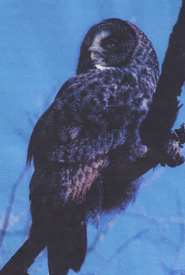
Great grey owl North America's, and one of the world's biggest owls and a denizen of the boreal forest. (Photo by Dr. Henry Barnett)
The biggest owl in North America is the great grey owl, who is a denizen of the boreal forest. His average length is 27 inches, compared with snowy at 23 and the horned owl at 22 inches.
Occasionally a southern eruption of great grey owls occurs and we see several of them of which this picture (left) was a representative. They found mice aplenty in the neighbourhood of an old barn on the northern fringes of the Happy Valley Forest. One pair liked it so much that they stayed and nested hundreds of miles from their usual habitat. This was a first for southern Ontario.
My mother was tolerant of my habits. One Sunday morning three saw-whet owls were perched on her dining room plate-rails. Places had been set for another Thanksgiving dinner. My mother’s patience was put to the test when one of the three owls flew across the table and deposited the contents of his colon on the freshly ironed and starched tablecloth. No irritable comment was made but I never parked saw-whets in the dining room awaiting banding on other occasions.
Dawn and dusk calling include other birds than just owls. This includes the woodcock who makes a noise like a muted nighthawk heard deep in the damp forest.
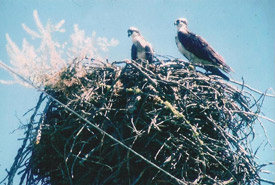
Note the primitive looking stick nest atop a telephone pole. Generally it does not disturb the function provided by these wires. (Photo by Dr. Henry Barnett)
Osprey
The osprey is the principal predator living on fish, for which it dives precipitously. Its primitive looking, huge stick nest is built on tree tops or more often on telephone and hydro poles. Nowadays it can be encouraged to nest on man-made, flat surfaces atop poles 30 feet in the air.
This is the seventh in a series of blog posts Dr. Barnett will be contributing to Land Lines in the next few months.

